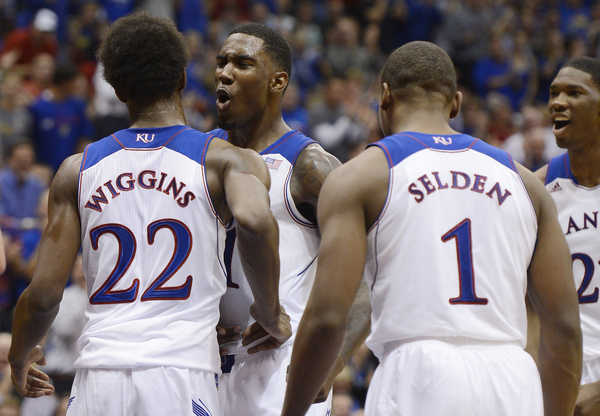Let’s talk about Landen Lucas
The redshirt junior from Portland, Oregon has cemented himself as Kansas’ starting big man, providing some stability to what has been an otherwise-puzzling big man rotation. Let’s look at what has separated Lucas from KU’s other big men as well as how the team has fared as a result of his insertion into Bill Self’s starting lineup.
As far as Kansas big men are concerned, 2015-16 was supposed to be the year of Cheick Diallo, just as 2014-15 was supposed to be the year of Cliff Alexander, thanks to the terrific 2013-14 season put in by Joel Embiid. In comparing this small sample of three highly-touted KU big men, it is easy to see Embiid as the outlier – a true freshman big that flawlessly integrated into Bill Self’s schemes on both ends of the floor. Though fans may often be frustrated by Self’s lack of faith in the younger big men, it is now clear that Self has found his anchor for his 2015-16 Jayhawk squad.
Landen Lucas was first inserted into the starting lineup on Jan. 23, when Kansas hosted the Texas Longhorns at Allen Fieldhouse. Heading into this matchup, KU had lost two of its last three, and Bill Self had struggled to get any sort of meaningful production from the starting center position. The lineup vs. Texas was the fifth different starting lineup Self had mobilized this season, featuring Jamari Traylor, Hunter Mickelson, and Cheick Diallo at the center position before giving Lucas the nod.
The result has been a drastic change in the trajectory of Kansas’ season, as the team has gone on to win nine of ten games with Landen Lucas as the starting center. In those ten games, Lucas has played an average of 21.8 minutes per game, compared to the 10.4 minutes per game that Hunter Mickelson featured in during his run of ten straight starts. Not only is Lucas giving the Jayhawks more in terms of steady minutes, but his production, especially in Big 12 play, has been incredible. Lucas ranks in the top ten of the Big 12 in the following categories: offensive rating, offensive and defensive rebound percentage, block percentage and two-point field goal percentage. Lucas’ ability to rebound, block shots, and score efficiently has been exactly what Kansas has needed out of the center position.
Not only has Lucas’ emergence helped Kansas in terms of production, it has also helped solidify a once volatile big man rotation. Now, Self has narrowed the rotation behind Lucas to Traylor, Diallo, and Bragg, who are now all receiving limited, but consistent minutes. This rotational stability has helped cement roles that were previously up for grabs or non-existent.
Where Lucas appears to be most valuable, however, is on the glass. Playing with a group of talented, high-usage perimeter players in Frank Mason, Devonte’ Graham and Wayne Selden allows for plenty of offensive rebound opportunities. In Big 12 play, Lucas is grabbing offensive rebounds at a nearly 17% clip. By extending these possessions, Lucas gives an already-efficient Kansas offense even more chances to score. Factor in his 24% defensive rebound rate, along with his 4% block rate, and his impact on the game proves to be monumental, regardless of his raw scoring numbers.
Though Joel Embiid-like offensive production would be nice, it was not realistic to expect such output from this crop of big men. What this KU team needed was a big body with plus rebounding, shot-blocking, and screen setting ability. The framework of this team, which relies on ball movement, spacing, and efficient, balanced scoring has been significantly bolstered by the insertion of Landen Lucas into the starting lineup. As improbable as this may have seemed before the season started, Landen Lucas has emerged as one of the most effective big men in the Big 12, as well as a major difference-maker for this Kansas team.






Pingback: Honoring the 2016 Jayhawk Seniors
ivermectin 3mg pill http://stromectolfive.online# how much is ivermectin